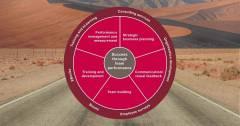Of all the things I’ve done, the most vital is coordinating the talents of those who work for us and pointing them toward a certain goal.
Walt Disney
What is a unified sense of direction and how do you develop one?
The first essential component of team performance is a unified sense of direction. A unified sense of direction can best be summed up in the phrase one team, one direction. It means that all the departments, teams and individuals that make up an organization are pulling in the same direction. Or to put it another way, everyone is singing from the same song sheet and is working harmoniously together to achieve common goals.
To achieve a unified sense of direction there needs to be an agreement at all levels on what the organization values, what it does, where it is headed and how it plans to get there. This is how one of our clients described their plant after we had implemented a unified sense of direction:
We all work smarter. We discuss things more. More operators want to be developed and show commitment and enthusiasm. The supervisors are now less “hands-on” but more committed to the development of their teams…they are more professional – they realize the training of their operators and themselves is essential but must be carefully planned and conducted – they’re committed to discuss and consult and give up power – they know what they get in return. There is no going back – a new level of consciousness has developed.
Dennis Sparrow, Plant Manager, Michell
The 10 Musts of developing and implementing a unified sense of direction
- The unified sense of direction must be leader initiated. Of all the essential components of team performance, this is the one that is the unique contributions of the leader. The troops in the trenches are not in the position and do not have the altitude to determine the way forward. Napoleon Bonaparte was reported to have said that there are no bad soldiers, only bad officers. A good manager is one who leads by example and from the front. While this is true of many situations requiring improvement, nowhere is it more so than in the creation of a unified sense of direction..
- The unified sense of direction must be in writing. It must include where the team is going, (vision), what it does, (mission) and what it thinks is important, (values).
- The unified sense of direction must be measured, both quantitatively and qualitatively. What gets measured gets done.
- The unified sense of direction must be consciously and systematically implemented at all levels in the organization. It won’t happen on its own, or in a random fashion.
- The unified sense of direction must be developed and cascaded in teams. It comes to life as it cascades down through an organization. Every department and every individual in the organization should be able to adapt and apply the corporate vision. They should create their own unique team USD; these USDs should not only support and align with management’s vision but should also express their own aspirations in a way that’s consistent with their organization’s overall purpose. What do they want their team to be? Their USD must be their own. It must be personal and meaningful to the local team. It must enable the local team and the leadership team to share a profound commitment – in a form that is meaningful to every individual.
- The unified sense of direction must be a focal point for each team. What you focus on gets bigger. The USD is the North Star for both the teams and the individuals in an organization.
- The team unified sense of direction must be trusted, liked and understood by the team members.
- Each team must be given the opportunity to develop their own unified sense of direction. Team members will trust, like, understand, (and never criticize), what they create. Few people would argue with the fact that the greater the degree of involvement and participation at all levels, the greater the chances of success. The more people interact, psychologists tell us, the greater the possibility that they will share common values and norms. Participation and involvement also result in improved understanding, and therefore trust, because generally, people do not trust what they don’t understand. The best way to generate trust and understanding is to directly involve people in the creation of that aspect of a unified sense of direction that can be directly applied to the area of the organization in which they work.
- Each team’s unified sense of direction must be vertically and horizontally aligned with every other team’s USD.
- The emphasis in the unified sense of direction must be on what teams have in common, rather than their differences. General Colin Powell attributes the unified sense of direction achieved by the 80 nations involved in the first Gulf War to focussing them on what they had in common, which he defined as “kicking Iraq out of Kuwait” Other well-known examples of calls to unity are JFK's: "we are going to put a man on the moon and bring him home safely by the end of the decade", and the motto of the Israeli airforce, "Clear skies over Israel".
For more information on how to develop a unified sense of direction we refer you to our online workshop: A Commonsense Approach to Business Planning
TALK TO US ABOUT HOW WE CAN HELP YOUR BUSINESS
Book an obligation free clarity call to discuss our programs and your requirements.
Online Access, on our Learning Management System, or yours, to all five Sacher Associates courses:
- A Commonsense Approach to Business Planning
- Performance Measures Applied
- Performance Linked Communication
- Success Through Team Performance
- Performance Linked Learning
Discover how we can help your business increase productivity and improve performance:
- Discussion on consulting requirements
- Diagnostic review of your company
- Multiple User Access
- Access to Sacher Associates exclusive closed Facebook Group
- Customised courses and delivery solutions








